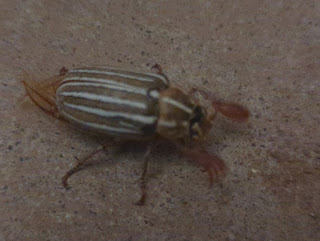Hot weather is very miserable for humans and this year is breaking records. Swamp coolers don't work as well, streets are too hot for the dogs to walk on. There is stress on humans, and also all organisms in an ecosystem, although that can show in different, unexpected ways.
Crab spiders, wolf spiders, and jumping spiders as some of the most visible arachnids seen during the day. This one shows signs of missing legs, a common sacrifice insects use to avoid predation, especially by birds. This strategy, called autotomy is also common in insect courtship as well.
This unusual insect is a thread legged bug. Its hard to see its two front legs which are held up like a praying mantis (raptorial). This is a pretty cryptic species, but many of this type hunt spiders.
The Klug's velvet ant is a wasp that parasites other wasp's eggs. The stiff hair and tough armor probably help the wingless females fend off attacks from wasps and ants it encounters while hunting for burrows of other wasps. While it has a reputation for a painful sting (nicknamed cow killers) this fact is not the most interesting thing about them. They have rows of hair called "felt lines" that not only release irritant venom, but also releases noxious smelling chemicals if they bothered by ants or other predators.
Grasshoppers are so common that not many people think about them other than that they are pests. This seems like such a strange concept; much of our knowledge of common insects is how to destroy them. Many cultures eat grasshoppers, oddly this idea has yet to take off in the US.
There is a lot of interest in eating this invasive pest, which are currently repopulating along the unlined acequias by the river. New Mexico does not have much of a tradition of crayfish boils, which is a bit of a shame considering how many there are right now. These arthropods are tough and versatile animals, burrowing into the mud to wait out cold and dry conditions, while being able to hunt and scavenge on anything they can find.
Many insects have a very short window of time to find mates and reproduce, they take their search for mates very seriously. The ten lined june beetles use huge, sensitive antennae to sniff out females who are still maturing underground
The giant cicada killer wasps are also in a race to find emerging cicadas to paralyze and lay eggs inside of. While ferocious looking, they are completely obsessed with their tasks and barely notice the humans around them.
There are many types of insect hunters, some of the most voracious are the dragonflies, like this meadowhawk which specializes in patrolling along areas of vegetation, rather than darting out over open water from a ambush site.
Robber flies are seen during the hottest months of the year and can hunt in a very similar fashion. They are some of the largest types of flies that can often be seen hunting bees.
They are coming to the end of the breeding season, but the summer tanager males are still displaying and calling to keep their territories, but only if you know where to look. This bird has a reputation for shyness, but I have to admit, that is not my experience in Corrales.
This poor picture shows one of the younger great horned owls against the evening sky. These huge birds have fully fledged but are not quite ready to live without their parent's hunting skills just yet.
There are many lizards around in this heat, many of those you will see have regrowing tails. This is often because of domestic or wild predators. While the tail will regrow, it has a detrimental effect on the overall population, especially in areas of high predation. Domestic pets are a well known cause of death of lizards, birds, and small mammals of all kinds. Both dogs and cats cause mortality. While there is no chance we will run out of fence lizards any time soon, this is one more stressor on the environment that we did not need.













Thank you Alexander Price for helping your Corrales neighbors learn all about our wildlife
ReplyDeleteCould you write more about the broom rape?
ReplyDelete